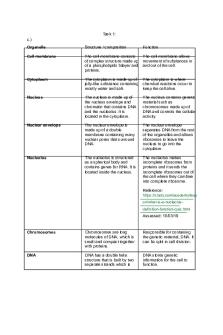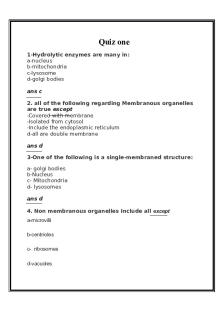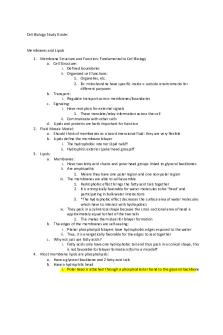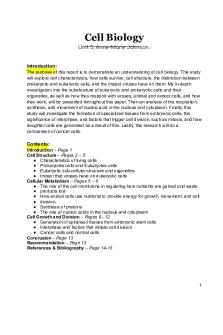Cell Types and other biology stuff PDF

| Title | Cell Types and other biology stuff |
|---|---|
| Course | Human Biology |
| Institution | University of Iowa |
| Pages | 5 |
| File Size | 460.8 KB |
| File Type | |
| Total Downloads | 34 |
| Total Views | 158 |
Summary
Human Biology Human Biology Human Biology...
Description
Name:
Sadie Gorsch
Date:
9/13/21
Student Exploration: Cell Structure Directions: Follow the instructions to go through the simulation. Respond to the questions and prompts in the orange boxes. Vocabulary: cell membrane, cell wall, capsule, centriole, chloroplast, cytoplasm, cytoskeleton, endoplasmic reticulum, flagellum, Golgi apparatus, lysosome, mitochondria, nucleoid, nuclear membrane, nucleolus, nucleus, organelle, pilus, plasmid, plastid, ribosome, vacuole, vesicle Prior Knowledge Questions (Do these BEFORE using the Gizmo.) 1. What are some of the structures inside a cell that help it to live and perform its role in an organism? The mitochondria, the nucleus, the cell wall, and the cell membrane. 2. How do you think plant cells differ from animal cells? (Hint: What can plants do that animals cannot?) Plant cells can produce their own food, animal cells can not. Gizmo Warm-up The Cell Structure Gizmo allows you to look at typical animal, plant, and bacterial cells under a microscope. On the ANIMAL CELL tab, click Sample to take a sample of an animal cell. On the dropdown menu, select Centriole. 3. Find the centrioles (Highlighted in green). Make a sketch of the centrioles in the space below. Either hand draw in the space below or edit using the drawing tools.
4. Read the description of the centrioles. What is their function? They help organise the movement of chromosomes during cell division
Reproduction for educational use only. Public sharing or posting prohibited. © 2020 ExploreLearning™ All rights reserved
Activity A:
Get the Gizmo ready:
Animal cells
● Check that an Animal cell is mounted on the microscope.
Question: Organelles are specialized structures that perform various functions in the cell. What are the functions of the organelles in an animal cell? 1. Label: Locate each organelle in the animal cell. Label the organelles in the diagram below. (Double-click on each box, then add the text to the box and click Save and Close.)
2. Match:
to its function/description.
H
Cytoplasm
A.
Structure that organizes motion of chromosomes.
E
Lysosome
B.
Stack of membranes that packages chemicals.
F
Mitochondria
C. Membrane that protects the nucleus.
A
Centriole
D. Membrane that surrounds and protects the cell.
G
Endoplasmic reticulum
E.
Sac filled with digestive chemicals.
M
Vacuole
F.
Structures that convert nutrients to energy.
D
Cell membrane
G. Passageways where chemicals are made.
J
Nucleus
H. Jelly-like substance within the cell membrane.
N
Cytoskeleton
I.
Structure that manufactures ribosomes.
L
Ribosome
J.
Structure that contains DNA and regulates genes.
C
Nuclear membrane
K.
Package created by the Golgi apparatus.
B
Golgi apparatus
L.
Small structure that synthesizes proteins.
K
Vesicle
M. Sac that stores water, nutrients, or waste products.
Nucleolus
N. Tubules and filaments that give the cell its shape.
I
3. Investigate: Select the Cell membrane. Turn on Show closeup. Read the description, watch the animation, and answer the following questions below. A. What kind of molecules diffuse (go through) the cell membrane directly?
Reproduction for educational use only. Public sharing or posting prohibited. © 2020 ExploreLearning™ All rights reserved
Small, uncharged molecules can get through the cell membrane directly. B. How can some large molecules and charged ions get through the cell membrane? Some can get through by entering through special transport proteins. 4. Investigate: Select the Nuclear membrane closeup. How is the nuclear membrane similar to the cell membrane? The nuclear membrane has the same job as the cell membrane except it only surrounds the nucleus. 5. Investigate: Select the Mitochondrion closeup. What happens inside the mitochondrion? The mitochondrion breaks apart molecules to form new molecules that provide the cells with nutrients. 6. Investigate: Select the Ribosome closeup. How does the cell make proteins inside the ribosome? It combines different amino acids to make new proteins. 7. Investigate: Select the Vesicle closeup. How do vesicles move through the cell? They are pulled along by a protein called kinesin that “walks” along microtubes.
Reproduction for educational use only. Public sharing or posting prohibited. © 2020 ExploreLearning™ All rights reserved
Activity B:
Get the Gizmo ready:
Plant cells
● Select the PLANT CELL tab, and click Sample.
Question: What functions do the organelles in a plant cell perform? 1. Label: Locate each organelle in the plant cell. Label the organelles in the diagram below. (Double-click on each box, then add the text to the box and click Save and Close.)
n animal cell, but not in a plant cell? An animal cell has cytoplasm and lysosome. What structures are present in a plant cell, but not in an animal cell? A plant cell has chloroplast and a cell wall. 3. Fill in: Name the organelle or organelles that perform each of the following functions. A. B.
Chloroplasts The
convert sunlight to chemical energy.
cytoskeleton
, the
cell wall
, and the
cell membrane
support the plant cell and help it to maintain its shape.
C.
Vacuole
store food or pigments.
D.
Mitochondrion
Activity C: Bacterial cells
convert food into energy. They are found in plant and animal cells.
Get the Gizmo ready: ● Select the BACTERIAL CELL tab and click Sample.
Reproduction for educational use only. Public sharing or posting prohibited. © 2020 ExploreLearning™ All rights reserved
Question: Organelles are specialized structures that perform various functions in the cell. What are the functions of the organelles in an animal cell? 1. Label: Locate each organelle in the animal cell. Label the organelles in the diagram below. (Double-click on each box, then add the text to the box and click Save and Close.)
2. Match: Read about each organell D
Capsule
A.
Hair-like structure that the cell uses for movement.
C
Nucleoid
B.
Hair-like structure that attaches the cell to a surface and can transfer genetic material from one cell to another.
E
Plasmid
C. Region inside the cell that contains genetic material but is not surrounded by a nuclear membrane.
A
Flagellum
D. Outermost layer of the cell that provides protection.
B
Pilus
E.
Circular piece of genetic material.
3. Compare: What structures are present in a bacterial cell, but not in a plant or animal cell? A bacterial cell contains pilus, a capsule, and a flagellum. What structures are present in plant and animal cells, but not in a bacterial cell? Plant and animal cells both have a nucleus and a mitochondria. What structures inside plant and animal cells look like bacteria?
The mitochondria look similar to a bacteria cell.
Chloroplasts and mitochondria have their own DNA. Long ago, these structures may have originated as bacteria that were engulfed (eaten) by larger cells.
Reproduction for educational use only. Public sharing or posting prohibited. © 2020 ExploreLearning™ All rights reserved...
Similar Free PDFs

Cell biology and genetics
- 12 Pages

Cell and molecular biology
- 16 Pages

HSC Exam Planner and other stuff
- 19 Pages

Cell biology
- 3 Pages

Cell Types SE - bio
- 9 Pages

Cell Biology Quiz CELL ORGANELLES
- 10 Pages

Cell Types Gizmo Worksheet
- 10 Pages

Cell Types Worksheet PDF
- 9 Pages

Cell Biology Study Guide
- 37 Pages

Cell Biology unit (5)
- 14 Pages

Cell Biology Syllabus 2019
- 5 Pages

Apoptosis - Summary Cell Biology
- 4 Pages

Cell biology exam, answers
- 11 Pages

Cell biology lecture notes
- 108 Pages
Popular Institutions
- Tinajero National High School - Annex
- Politeknik Caltex Riau
- Yokohama City University
- SGT University
- University of Al-Qadisiyah
- Divine Word College of Vigan
- Techniek College Rotterdam
- Universidade de Santiago
- Universiti Teknologi MARA Cawangan Johor Kampus Pasir Gudang
- Poltekkes Kemenkes Yogyakarta
- Baguio City National High School
- Colegio san marcos
- preparatoria uno
- Centro de Bachillerato Tecnológico Industrial y de Servicios No. 107
- Dalian Maritime University
- Quang Trung Secondary School
- Colegio Tecnológico en Informática
- Corporación Regional de Educación Superior
- Grupo CEDVA
- Dar Al Uloom University
- Centro de Estudios Preuniversitarios de la Universidad Nacional de Ingeniería
- 上智大学
- Aakash International School, Nuna Majara
- San Felipe Neri Catholic School
- Kang Chiao International School - New Taipei City
- Misamis Occidental National High School
- Institución Educativa Escuela Normal Juan Ladrilleros
- Kolehiyo ng Pantukan
- Batanes State College
- Instituto Continental
- Sekolah Menengah Kejuruan Kesehatan Kaltara (Tarakan)
- Colegio de La Inmaculada Concepcion - Cebu

